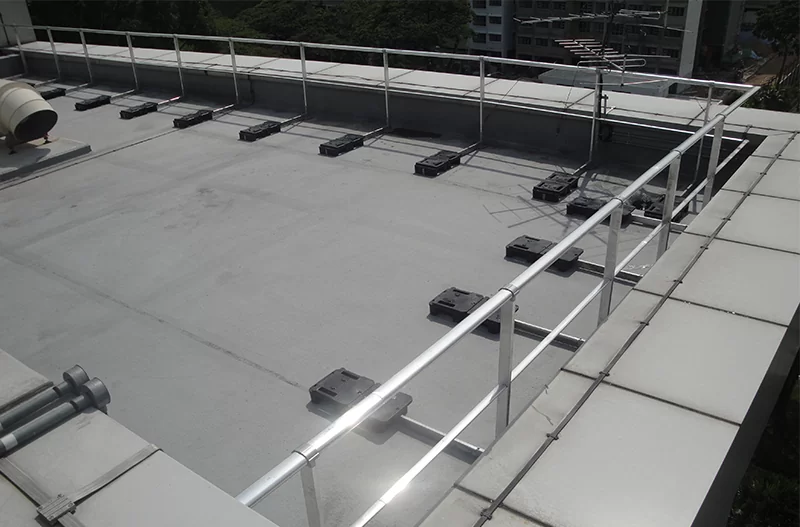Safety guardrail systems play a crucial role in preventing falls and ensuring the safety of workers in various industries. Whether on construction sites, manufacturing floors, or rooftops, these systems create a barrier that helps protect employees from potential accidents. Regular maintenance and inspection are essential to ensure that these systems perform optimally and continue to provide the protection they are designed for. In this blog, we’ll guide you through the best practices for maintaining and inspecting safety guardrail systems.
Understanding Safety Guardrail Systems
Safety guardrail systems come in various types, including permanent, portable, and customized solutions. Permanent guardrails are designed for long-term installation on rooftops, platforms, and walkways. They are robust, durable, and engineered to withstand various weather conditions. Portable guardrails are versatile and ideal for temporary or changing work environments. Lightweight yet sturdy, they offer quick setup and removal. Customized solutions are tailored to specific needs, ensuring optimal protection and compliance with industry standards.
Choosing the right type of guardrail system for your environment is crucial to ensuring safety and compliance. Each type has its unique advantages and is designed to meet different requirements.
Why Regular Maintenance is Crucial
Regular maintenance of safety guardrail systems is essential to prevent potential hazards and ensure ongoing safety. Over time, guardrails can experience wear and tear due to environmental factors, usage, and general aging. Common issues that arise without proper maintenance include rust, loose fittings, and structural damage. Addressing these issues promptly can prevent accidents and extend the lifespan of the guardrail system.
Step-by-Step Guide to Inspecting Safety Guardrail Systems
Initial Visual Inspection: Start with a visual inspection of the entire guardrail system. Look for any obvious signs of wear and tear, such as rust, dents, or bent components. Check that the guardrails are firmly in place and that there are no loose or missing parts. A visual inspection helps identify immediate issues that need attention.
Detailed Inspection: Conduct a more detailed inspection by examining individual components, including posts, rails, and connectors. Look for signs of rust, corrosion, or physical damage. Ensure that all fittings are secure and that there are no loose or missing screws, bolts, or other fasteners. This step ensures that each part of the guardrail system is functioning correctly.
Functional Testing: Perform functional testing to ensure that the guardrails are operating as intended. This includes checking that the guardrails meet industry standards for height, strength, and stability. Verify that they provide the necessary protection and are in compliance with relevant safety regulations.
Maintenance Procedures for Safety Guardrail Systems
Cleaning and Upkeep: Regular cleaning is essential to remove debris, dirt, and corrosive substances that can damage guardrails over time. Use appropriate cleaning agents and tools to ensure that the guardrails remain in good condition. Keeping the guardrails clean helps prevent corrosion and maintains their effectiveness.
Repairs and Replacements: Address any issues identified during inspections promptly. Tighten loose fittings, replace damaged sections, and address any signs of rust or corrosion. Ensure that any repairs or replacements are done using high-quality materials and in accordance with safety standards.
Professional Inspections: For comprehensive inspections and repairs, consider hiring a professional. Experts can conduct a thorough assessment of the guardrail system, identify any hidden issues, and ensure that all components are in compliance with safety regulations. Regular professional inspections can provide peace of mind and ensure ongoing safety.
Documentation and Compliance
Keeping detailed records of all inspections and maintenance activities is crucial for ensuring compliance with industry regulations. Documentation helps track the condition of the guardrail system, provides evidence of compliance, and assists in identifying trends or recurring issues. Ensuring that your guardrail system meets industry standards and regulations is essential for maintaining safety and avoiding potential legal issues.
Takeaway
Maintaining and inspecting safety guardrail systems in the philippines are critical practices for ensuring optimal performance and protecting workers. By following the guidelines outlined above, you can help prevent accidents, extend the lifespan of your guardrails, and ensure ongoing safety compliance. For expert advice and comprehensive solutions, contact 828 Cable System Inc. to assist with your safety guardrail system needs.

